

For example, AMD was able to press Nvidia hard on this point as recently as the Kepler-Hawaii product cycle, most notably with the $400 R9 290. That’s because recent generational advances in graphics cards have delivered new levels of graphics performance to the same price points we’ve grown used to. On top of that, plenty of gamers are just plain uncomfortable with any generational price increase from the GTX 1080 to the RTX 2080. Our back-of-the-napkin math puts the RTX 2080’s rasterization capabilities about on par with those of the 1080 Ti, and rasterization resources are the dukes the middle-child Turing card has to put up today.
TROUBLE 4K VIDEOS ON YOUTUBE ON NVIDIA GEFORCE GTX 960 SOFTWARE
That’s not a comfortable place to be, given that software support for Turing’s unique features is in its earliest stages. Right now, pricing for the RTX 2080 puts it in contention with the GeForce GTX 1080 Ti. To be fair, Nvidia introduced the GTX 1080-which this card ostensibly replaces-at $600 for partner cards and $700 for its Founders Edition trim, but that card’s price fell to $500 after the GTX 1080 Ti elbowed its way onto the scene.


At a suggested price of $700 for partner cards or $800 for the Founders Edition we’re testing today, the RTX 2080 is hardly cheap. So far, that mission falls to the GeForce RTX 2080. Nvidia’s GeForce RTX 2080 Ti has already proven itself the fastest single graphics card around by far for 4K gaming, but the $1200 price tag on the Founders Edition card we tested-and even higher prices for partner cards at this juncture-mean all but the one percent of the one percent are going to be looking at cheaper Turing options.


 0 kommentar(er)
0 kommentar(er)
